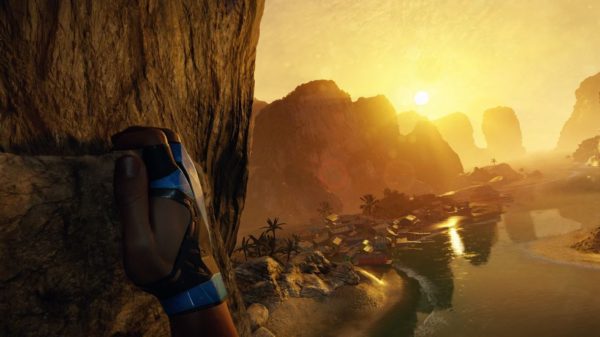Crytek’s The Climb Is A VR Mountain-climbing Experience For The Rift

Many of the available VR experiences today are starting to get clearer for consumers as VR headsets are inching closer to their commercial launch. With the imminent launch of the consumer-edition Oculus Rift next year, gaming giant Crytek has announced its own VR title for the Rift: The Climb.
As the name implies, the point of The Climb is to climb mountains. Players will navigate a series of hand-and-footholds, either by using motion controllers or a gamepad. You aim at new ledges by looking at them — you can jump if you can’t reach a new area just by aiming.
One thing Crytek’s developers are highlighting, even at this early stage, is that playing on VR is fundamentally different from playing on a PC. According to Crytek, the game is running at a steady 90 FPS at a resolution of 2160×1200. While the pixel count of 2160×1200 is only slightly higher than 1920×1080, the higher frame rate and the absolute necessity of steady delivery make this a tougher challenge. As detailed on the Oculus Rift blog, video cards need to be able to push at least 233 million pixels per second for smooth Oculus gaming, as compared to 123 million pixels to play at 60Hz in 1920×1080. Of course, smooth frame rates are about more than raw frame rate, but the different figures still illustrates the gap. At the “default eye-target scale,” Oculus thinks you’ll need to be able to push at least 400 million pixels per second.

A demo of The Climb seems conceptually quite similar to the Back to Dinosaur Island 2 demo that was presented at AMD’s E3 event this past summer. The primary difference is that Crytek has removed the extraneous bits of content to focus solely on building a top-notch climbing simulator. The demo video shows that mechanic in action; it’s hard not to look at the screen and wonder where your arms are.
If you are truly serious about getting these kinds of VR experiences and you think you are ready to jump into the high-end VR bandwagon, it’s not suggestive that you buy a supporting graphics card at the moment. Both AMD and Nvidia are planning to launch new architectures in 2016, and while there are no available performance benchmarks yet, the general 14-nanometer graphics chip process is expected to offer substantially reduced power consumption at the same performance.
For now, you can get the highest-performing graphics card you can get that supports VR experiences. Oculus specifies a GTX 970 minimum target for the optimum VR performance on the Rift. Games like The Climb, which focus on delivering an excellent VR simulation while doing a handful of specific tasks is the kind of content we expect to see a lot of in the next two to three years. Creating AAA titles that allow for the full range of traditional player activities is going to be quite challenging. Titles that do a handful of things well are a much easier lift — developers will presumably build on these concepts as time goes by and the rules for VR worlds are hammered out.
For more information on Crytek’s The Climb, please visit the following websites:
http://www.theclimbgame.com
http://arstechnica.com/gaming/2015/12/cryteks-oculus-debut-the-climb-successfully-tackles-vr-sickness-vertigo/
http://www.eurogamer.net/articles/2015-12-15-crytek-shows-off-vr-mountaineering-game-the-climb

